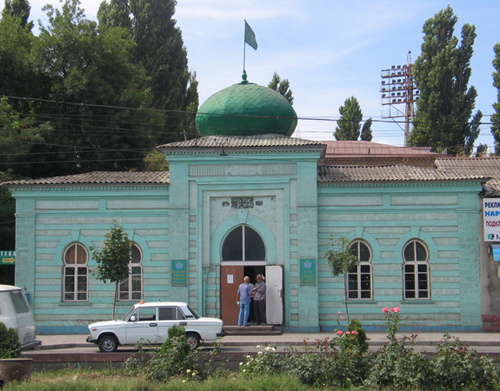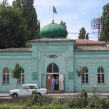
Who Is Training Dagestan’s Future Islamic Scholars?
Publication: Eurasia Daily Monitor Volume: 12 Issue: 86
By:

Dagestan is a special region of Russia in that it is an outpost of Islamic radicalism. Islamic institutions, madrasas and maktabs (Islamic elementary schools in mosques) exist in large numbers in the republic. Even though the number of Islamic educational institutions in the republic has been slashed by two-fold during the past decade, the situation has not been radically changed. Dagestan is currently home to eight Islamic higher education institutions that have 1,506 students; 39 madrasas with 4,196 students; and two cultural centers and 196 maktabs with 3,000 students. Of the 39 madrasas, only 12 are officially licensed by the authorities (President.e-dag.ru, July 1, 2014). Licensed Islamic institutions are obliged to follow the curriculum mandated by the authorities. They have to teach in Russian and ensure a 60-40 ratio of religious to secular subjects.
Why do children attend educational institutions that have no license and can be shut down any time? The simple explanation is that such institutions charge nothing and many, if not all, provide students also with lodging and meals. The Islamic institutions also exist in all districts of the republic, so their students do not have to move to the capital Makhachkala in order to receive a higher education. The republican authorities and the official Spiritual Board of Muslims of Dagestan are concerned about the fact that “only nine out of all the existing Islamic institutions in Dagestan are licensed. None of the Islamic higher education institutions is certified by the government or has accreditation with the state” (Islamnews.ru, May 14, 2012). So, in reality, every institution, madrasa or maktab defines its own policies concerning who and what to teach.
It is not surprising, therefore, that having so many Islamic institutions in the republic, the Dagestani authorities are also concerned about the growing number of young Dagestanis who travel abroad to study at the Islamic institutions of Saudi Arabia or Egypt. Those individuals who study abroad often later join the militants in Syria and Iraq. The Dagestani authorities called their students studying the Middle East back to the republic (Interfax , October 14, 2013).
A council of alumni of foreign Islamic institutions was recently set up in the republic (Islam-today.ru, April 30). It was apparently created so that the authorities could keep an eye on the alumni of the foreign Islamic institutions, considering them in the risk group of people most likely to be affected by radical Islamic teachings, and who might possibly join the armed Islamic resistance in Dagestan. On March 23, Moscow’s envoy to the North Caucasus Federal District, Sergei Melikov, said that the Islamic State organization had recruited students from institutions of higher education in the North Caucasus. To battle Islamic State recruitment, Melikov proposed focusing on the “extracurricular activities” of the students and their patriotic upbringing (Golosislama.ru, March 27). Despite denials by government officials, it has long been known that the average militant in the North Caucasus is either a student at or a graduate of a higher education institution.
Educational institutions operating under the auspices of the official Spiritual Board of Muslims of Dagestan are almost always schools associated with specific Sufi sheikhs. These include the Sheikh Muhammad-Arif University in Makhachkala, the Sheikh Sharapudin Al Kikuni School in Makhachkala, the Saifulla Kadi School in Buinaksk and the Sheikh Abdullah Efendi School in Derbent. Three Sufi tariqats (orders) exist in Dagestan—the Naqshbandi, Shadhili and Qadiriyya—and they compete with the Salafis, who also have their own educational institutions at the level of madrasas. The authorities have, at times, forcibly shut down Salafi institutions, as happened to a Salafi women’s madrasa in Khasavyurt district (Kavkazsky Uzel, October 16, 2013), which was closed down because it was financed by one of Dagestan’s leading Salafi preachers, Abu Umar Sasitlinsky.
Sufi educational institutions also face problems, however, such as the institution associated with the famous Sufi sheikh, Said Chirkeisky, in the village of Chirkei, which was recently stripped of its government license. Said Chirkeisky was killed by a female suicide bomber back in August 2012 (Regnum , April 27). The government also ordered the closure of the Sheikh Jamalutdin Kazikumukhsky madrasa.
Still, Dagestan remains the only region in Russia where Salafis operate openly. The Salafis were allowed to function in the republic in order to neutralize their influence on young people. However, Dagestani youth took the opportunity and started to join the Salafis and the radicals in large numbers. The Salafis are divided into two groups, one which is fighting the authorities and the other which refuses to take up arms to defend its views. As of today, there are no reliable estimates of the ratio of peaceful Salafis to violent Salafis, but the ratio is probably 1,000 to 1, i.e. one Salafi fighter per 1,000 peaceful Salafis. However, even the peaceful Salafis are closer to the violent Salafis than they are to the Sufis or to the government.
Even though the Salafis operate legally in Dagestan, they still have no freedom of association or right to build their own mosques. Mosques that are under Salafi control are constantly watched by the police.
Moscow does not want so many Islamic educational institutions in the country and would thus like to have just two Islamic institutions in the North Caucasus while simultaneously limiting travel by students abroad to obtain an Islamic education. The government’s moves in Dagestan indicate that Moscow is trying to solve the problem of armed resistance in the North Caucasus by replicating the experience of the Soviet era, when there was one Islamic institution in the entire country and its curriculum was written in the Kremlin. However, returning to the Soviet system would also bring back the problems of the past that radicalized Muslims, including those in areas that were considered to be Sufi dominated.




